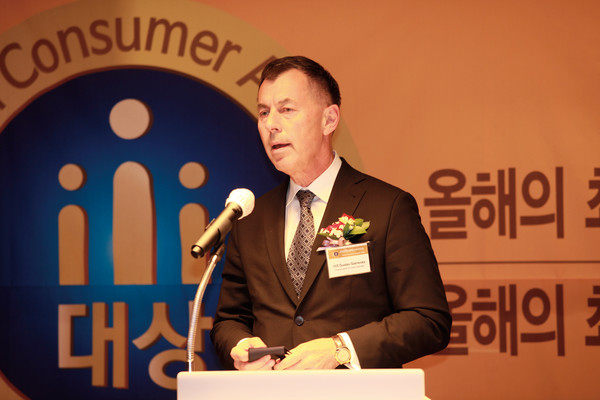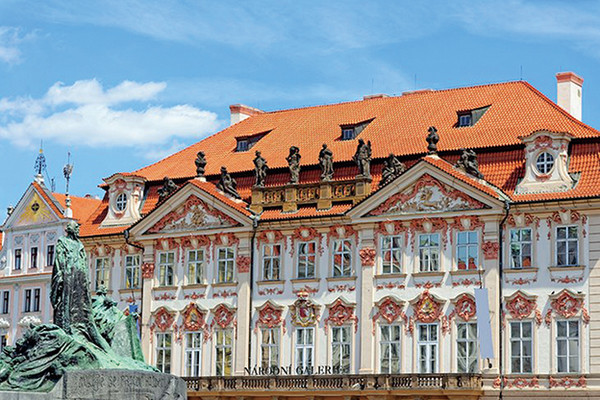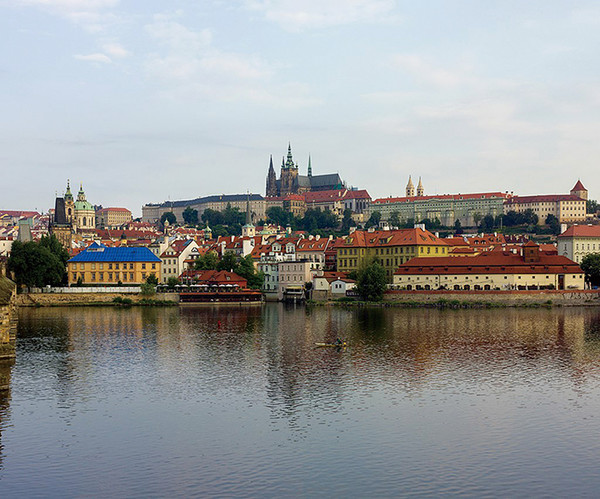
Q. Please introduce the significance of your Independence Day, October 28th and make an independence Day message to our readers.
Also known as Foundation of the Independent Czechoslovak State Day. On October 28, 1918 the first independent Czechoslovak state was founded from territories that were previously part of the Austro-Hungarian Empire. President Tomáš G. Masaryk became the leader of a state that had been based on the President Woodrow Wilson’s 14 points, especially the principle of self-determination.
Czechoslovakia became one of Europe’s first successful multi-party parliamentary democracies, and it was stable enough to withstand the international depression of the 1930s. The ‘First Republic’ only lasted two decades until Nazi Germany occupied the Czech Lands in 1938-39.
Although Czechoslovakia no longer exists today, Czechs continue to view October 28 as the day of their national founding. On this day, the President of the Czech Republic, together with key members of the government, places flowers on the grave of President Masaryk. In the evening, the Czech president presents state honours to the leaders of cultural and social life in the Czech Republic. The ceremony takes place in Vladislav Hall at the Prague Castle.
In October 1919, the first authorized national holiday was 28th of October – the day of the birth of Czechoslovakia. Already in the interwar period, 28 October was the day of rest – for its violation, even the fine could be imposed. Probably the saddest celebrations of October 28 were celebrated on the occasion of the 20th anniversary of the birth of Czechoslovakia in 1938, when this day even remained a normal working day. It was shortly after the Munich Conference, and instead of celebrations, being prepared for over a year, the nation was grieving. The Lidové noviny newspaper appeared with the title ‘Celebration in tears’. Almost the same day exactly twenty years after the legalization of October 28, it was cancelled in October 1939. Nevertheless, this day was the day of the largest demonstrations for the entire Protectorate Bohemia and Moravia area. Two years later, London’s foreign resistance leadership planned this day as the original date of the assassination of Reinhard Heydrich. After the war, the status of October 28 gradually changed dramatically. The Communists, who had already fought for the abolition of this national holiday in 1925, tolerated it only until 1951 when it was replaced by Nationalization Day. Shop windows were on this day decorated by posters with the inscription: “There would be no October 28 without 7th November,” reminiscent of the importance of the October Revolution in Russia. In November 1951, the only national holiday was the 9th of May – the Day of Liberation of Czechoslovakia by the Soviet Army. Days of rest remained, except for 1 January, 25 and 26 December, only Labour Day on May 1 and Nationalization Day on October 28. In September 1988, October 28 – the Day of creation of an independent Czechoslovak state, was added to 9 May as a national holiday. So this day, celebrated in the year of 70th anniversary of the Republic’s birth, became a celebration of the approaching end of Communist power.
At the end of October 1918, long-standing efforts of the Czech political representation and the Czech nation as a whole were crowned and the independent state was established. Nowadays we memorialize the Day of Declaration of Czechoslovakia as a national holiday.
In the course of autumn 1918, the end of the World War I was drawing near; it was a terrible conflict, which irrecoverably marked Europe and influenced the lives of million people. Austria- Hungary, not loved but tolerated state by Czech people, inhabited by a number of other nations of central and Eastern Europe, was at the end of its tether. The way to independence, about which they had not dreamed of, became open to national entities. The Czech political representation concentrated in the national Committee was preparing for gaining independence, nevertheless it had not expected such a fast breakdown of the monarchy at the end of October 1918. It can be documented by the fact that some of the leading representatives of the national Committee were not present in Prague then as they left, upon a permission of the Austria-Hungarian government, to Geneva where they intended to meet the representatives of the exile political representation.
Not even the exile representatives concentrated around the subsequent president T.G. Masaryk did not expect such a fast end of the war. Edvard Beneš expected the end of the conflict as late as in the spring 1919 when the will of states of so-called Triple Entente supported by American troops on the west front was expected to prevail. In spite of this fact the exile representatives made number of steps to markedly strengthen the position of exile organs; these steps resulted in the acknowledgement of the Czechoslovak National Council, supreme organ of the national revolt, as a future Czechoslovak government from the side of the individual Triple Entente powers in the course of 1918. An imaginary full stop that followed these efforts, was the proclamation of so-called Washington Declaration on 18 October 1918, in which T.G. Masaryk declared in the name of the interim government the future Czechoslovak state including its basic principles.
As it has been mentioned, at the end of October 1918, part of leading political representatives was not present in Prague. Those who had not left for Geneva took advantage of the fact that the population understood the publication of the Andrássy Note as the end of the monarchy. In fact, the Austrian Minister of Foreign Affairs Gula Adrássy only asked the American president for starting peace negotiations based on the preliminary formulated conditions. However, among those conditions there was also a point concerning the right of nations for self-determination. People gathered in streets and a spontaneous removal of monarchy symbols began. The group of five significant politicians, later known as so-called "men of October 28" – Antonín Švehla, František Soukup, Jiří Stříbrný, Alois Rašín a Vavro Šrobár started to negotiate with the Austrian authorities. One of the most important acts was the takeover of the Corn Office in Prague, which was in charge of supplying Czech countries with foodstuff. Its distribution was one of the most burning problems and therefore the control over this office provided great power to the ‘men of October 28’. All the efforts were crowned by the adoption of the first law of the independent state, declaring that the Czechoslovak state came true.
In the days that followed the news on the establishment of the state was disseminated outside of Prague. Despite having no inkling on Prague events, representatives of the Slovak nation stood up for the future Czechoslovakia at the gathering in Turčianský Svätý Martin on 30 October 1918. The foundation of the state was definitely crowned after the arrival of the delegation from Switzerland. At the meeting of the National Committee on 14 November 1918, the interim constitution was adopted and the first Government of the Czechoslovak Republic headed by Karel Kramář was appointed. T.G. Masaryk was unanimously elected as the first President.

Q. Please introduce prevailing industry and special products of Czech Republic.
The economy of the Czech Republic is a developed export-oriented social market economy based in services, manufacturing, and innovation, that maintains a high-income welfare state and the European social mode.
The Czech Republic is also the most industrialized country in European Union. The industrial production accounts for 37.8 % of the economy, while services for almost 60% and agriculture for 2.5%.
More than half of Czech industrial production is exported. The biggest trade partner of the Czech Republic is the EU.
Intra-EU trade accounts for 84% of the Czech Republic’s exports. In terms of imports, 76% come from EU Member States.
The most important branch of Czech industry is vehicle manufacturing, including motorcycles and trailers, which has more than doubled in the past decade. The Czech Republic has a long aviation tradition and has always had a strong presence in the aerospace sector.
The other main pillars of Czech industry are the mechanical engineering, metals, chemical and food sectors. The energy, construction and consumer goods industries are also important components of the Czech economy.
The major services are research and development, ICT and software development, nanotechnology and life sciences among others.

Q. Please explain investment environments of Czech Republic for Korean potential investors and any special favors to foreign investors.
The Czech Republic is a fully-fledged parliamentary democracy and is one of the faster growing economies as well as one of the ten countries that entered the European Union on 1 May 2004. The country’s economic policy is consistent and predictable. A strong and independent central bank (the Czech National Bank) has maintained an extraordinary degree of currency stability since 1991. The Czech Republic was the first CEE country to be admitted into the OECD. The country is a member of NATO and is fully integrated into other international organisations such as the WTO, IMF and EBRD.EU legislation was adopted in preparation for EU accession. Czech commercial, accounting and bankruptcy laws are compatible with Western standards.
Investment safety
The Czech Republic is a developed countrywith a market economy. According to a numberof economic, social and political indicators, it ranksamong the world’s most advanced countries. Since2005, the Czech Republic has been part of the groupof the thirty most advanced countries accordingto the World Bank, to whose budget it has becomea contributor. The country is considered to havethe most stable and most prosperous economy of allpost-communist states. According to Eurostat, it wasthe seventeenth richest country of the EuropeanUnion in 2020 in terms of per-capita GDP basedon purchasing power parity. It was the most successfulof the new EU members.
The Czech Republic’s currency is the koruna. Dueto a foreign exchange intervention carried outby the Czech National Bank, the koruna-euro averageexchange rate in 2020 was CZK 26,50/EUR 1 (asat January 29, 2021). Upon accession to the EuropeanUnion in 2004, the country committed toadoptingthe single European currency.The Czech koruna is fully convertible. All international transfers (e.g. profits and royalties) related to an investment can be carried out freely and without delay.The Czech Republic’s national debt is low in comparisonwith that of other EU member countries. The developmentand current state of the country’s financesare also judged favourably in comparison with otherEuropean countries. In August 2011, Standard &Poor’s raised its rating of the Czech Republic by twoplaces, from A to AA-, which is the fourth-best possiblerating.
Inflow of Foreign Domestic Investment
The Czech Republic is one of the most successful transition economies in terms of attracting foreign direct investment. The introduction of investment incentives in 1998 stimulated a massive inflow of FDI to both greenfield and brownfield projects and since 1993 more than EUR 130.04 billion in FDI has been recorded.
As an early reformer in east-central Europe, the Czech Republic led the way in the early 1990s in adopting far-reaching stabilisation, liberalisation and privatisation programmes. The implementation of EU rules and regulations has also helped to improve the country’s business environment and attract FDI. According to the Economist Intelligence Unit, the Czech Republic has consistently attracted a high rate of foreign direct investment per capita since 2000, which confirms the country’s strong attractiveness for foreign investors.
The most important investors are Germany, the United States, Austria, Japan and the United Kingdom. A significant portion of FDI inflows into the Czech Republic has been concentrated in the automotive-components sector. The services sector, especially software, IT and financial services, has been the second-largest beneficiary. More investment is now being directed towards more high-technology sectors and research and development.
One of the most important investments in recent years was that of Toyota and Peugeot in 2002 involving the construction of a joint factory in Kolín at a cost of USD 850 million. As result, the Czech Republic became one of the most important players in the automotive sector in Europe. More recently, Hyundai built another large manufacturing plant at a cost of more than USD 1.2 billion in Nošovice. In 2004 Hewlett-Packard set up its regional computer-technology supply-chain headquarters for Europe, the Middle East and Africa in the Czech Republic. Several other multinational companies such as Honeywell, DHL, IBM, Sun Microsystems, Logica and Red Hat subsequently decided to use the Czech Republic’s potential in the services and R&D sectors.
Labour market
The Czech Republic has one of the lowest unemployment rates in the European Union. Despite that, one can still find suitable workers among the country’s unemployed and economically inactive people. All that is needed is to create more suitable conditions for them (most importantly part-time work, greater flexibility, retraining and/or education following recruitment). In reality, there are many more people available for recruitment on the market than the employment figures would suggest. The largest group consists of those who are currently employed but are interested in better conditions which would better suit their needs. Thus, there is considerable room for new investors.
In comparison to other CEE countries, Czech Republic has very well educated, skilled and multi-lingual labour force. Over the last years, average annual wage has grown due to the lack of employees in the Czech labour market. On the other hand, it is coming from much lower base compared to Western Europe.
Research and Development
The Czech Republic is home to a motivated workforce with a high degree of responsiveness to training and interest in continual professional and personal growth. The Czech Republic is already recognized as a prime location for European services-sector expansion and hosts an increasing number of business-support, research and customer-oriented services including expert solution centers, data processing and call centers as well as regional headquarters, value-added distribution centers and technology parks. Employment in high-tech services and manufacturing is also very prominent in the Czech Republic, providing input for the innovation activities of other firms in all sectors of the economy.
In the Czech Republic, the RD&I environment has beendeveloping vigorously in recent decades. Total expenditureon research and development has increasedover the long term; in 2019, a record EUR 4.23 billionwas spent on R&D.Businesses invested nearly EUR 2.64 billion in researchand development in 2019, mainly in in-house R&D.In 2019 statistics, EUR 53.59 million was spent in domesticpublic funding. However, the main objectivein funding is to create conditions for business expenditureto be at least 1.5% of GDP in 2025 and to reach 2%of GDP by 2030.
Transportation and Infrastructure
The Czech Republic possesses one of the most advanced transport networks in Central and Eastern Europe. Its geographical position at the very centre of Europe makes it a natural crossroads for major transit corridors. An extensive network of transport routes serves not only the Czech Republic but also links the country to neighbouring and other European states, and the density of the transport network ranks the Czech Republic among the world’s most advanced countries.
Besides the country’s transport infrastructure, itsenergy distribution and telecommunications networksalso contribute to the creation of an idealenvironment for doing business. Energy suppliesare very stable with some of the lowest pricesin the region. Both the electricity and gas marketsare fully liberalised without any regulations, onlyactivities of a monopolistic nature continue to beregulated. The Czech Republic’s energy infrastructureis among the most reliable, efficient andadequately supplied in the region, as the countryhas some of the largest gas reserves in the EU.
The Czech telecommunications market – oneof the most highly developed and most liberalisedin Central and Eastern Europe – is distinguishedby growing demand for data, internetand other communication services. The country’sadvanced fibre-optic network is part of the Europeanbackbone and is being further developed.No exclusive rights exist in the area of electroniccommunications and the competition environmentis sufficiently robust in the contextof the European Union. In terms of the business-property market, the country is quite advancedwith respect to the number of industrialzones and parks as well as office premises.
Investment Incentives
Czech and foreign legal entitiesand natural persons engagedin business can apply for investmentincentives. Only a legalentity with its registered officein the Czech Republic can bea recipient of investment incentives.
There are various forms of incentives: corporate income-tax relief for companies fora period of up to ten years. For new companies,this incentive is provided in the form of full taxrelief; for existing companies, in the form of partialtax relief.Cash grants for job creation in technology centresin the amount of EUR 7,500 per each newjob created. Cash grants for acquisition of assets for strategicinvestments in the manufacturing industryin the amount of up to 10% of eligible investmentcosts; in technology centres and high-techrepair centres, up to 20% of eligible investmentcosts. Cash grants for training and retraining of newemployees in technology centres in the amountof 50% of training costs.
CzechInvest: Your Gateway to Investment in the Czech Republic
The Investment and Business Development Agency CzechInvest is a state contributory organization subordinate to the Ministry of Industry and Trade of the Czech Republic.
In arranging investments, CzechInvest focuses on key sectors of the Czech economy, both in the manufacturing industry (production) and in research, development, and services (technology centers and business support services).
CzechInvest promotes the Czech Republic abroad as a suitable destination for investments. It is the exclusive organization that may submit applications for investment incentives to the governing bodies. The agency also supports Czech firms that are interested in becoming involved in the supply chains of multinational companies. Through its services and development programs, CzechInvest contributes to the development of domestic firms, Czech and foreign investors and the business environment as a whole.
In 2020, the Investment and Business Development Agency CzechInvest celebrated its 28th anniversary. The value of investments arranged by the agency to date approaches more than CZK 1 trillion (41,835 million USD).
Among its services, which are free of charge, you would find: assistance during implementation of investment projects; consulting services for foreign investors entering the Czech market;AfterCare services for foreign investors that are already operating on the Czech market; administration of a business-property database; support for suppliers – administration of a database of Czech supplier firms; mediation of state investment aid; mediation of contact with state administrative bodies and local authorities; partnering with entities in the research and development and academic spheres; assistance for the development of innovative start-up firms by means of the agency’s programs.
CzechInvest has nine foreign offices, one of which is located in Seoul. Do not hesitate to contact them for more information about the Czech Republic as well as thorough assistance with your investment project.

Q. What do you think would be the most attractive industrial sectors for Korean companies to invest in Czech Republic?
The change in the structure of foreign direct investment indicates a new trend in the Czech Republic. The number of demanding projects in the fields of research, development and business support services is rapidly increasing. New investors as well as those companies that formerly only came to the country with a production programme are now transferring their higher-value-added development activities (technology centres and business support services centres) to the Czech Republic
The most attractive industrial sectors for Korean companies to invest would be:
·Information and Communication Technology
·Life Sciences
·Nanotechnologies and Advanced Materials
·Technology transfer and applied research
·Business support services
·Retail sector
Q. Please introduce some outstanding Korean companies' activities in Czech Republic.
More than 70 Korean-owned companies currently operate in the Czech Republic, including major international companies such as Hyundai Motor Group, Nexen Tire, GS Caltex, Doosan, Hanwha, Hyundai Mobis, Plakor, Sungwoo Hitech, Kiswire and Koswire, which chose the Czech Republic as a gateway to European markets or for their EU headquarters. Korean companies employ over 16,000 people in the Czech Republic. The most active sectors include the automotive industry, plastics and metal processing, high-tech manufacturing, IT and software development, environmental technologies and finance.
Q. Please introduce tourist attractions of Czech Republic for Korean tourists abroad.
We can expect the whole tourism industry to resume in post-covid times in a bit different way than we were used to. Travellers and tourists might be more sensitive about health care, destination safety, social distancing, shared accommodation etc. It would not be an exaggeration to say that we might see more people searching for travel to nature, rental cars or even solitary evenings of watching stars in deserted places. In this sense, Slavkovský les (Slavkov Forest) of the famous spa city of Karlovy Vary and its healing valley offer a great opportunity for strolling and forest therapy. On the other hand, while driving rental cars, Korean travellers could easily organize a romantic tour around many Czech castles and chateaux forts - we have technically around 2000 of them in the Czech Republic. But I would recommend the South Moravian UNESCO area of Lednice and Valtice castles that are located in the midst of wineries and are surrounded by a peaceful landscape and preserve local Moravian folk culture, costumes and music till nowadays.
Q. Please let us know your point of view on how to strengthen further the close economic and cultural ties between Korea and Czech Republic in the years to come.
South Korean government has introduced for its strategic mission for the country's future called 'New Deal'.
Likewise, in the Czech Republic, we also have a strategy called “Innovation Strategy of the Czech Republic 2019–2030”. Part of the strategy is the introduction of a new brand “The Czech Republic: The Country For The Future”
In this strategy, we have major pillars as follows:
·Financing and Evaluation of Research and Development
·National Start-up and Spin-off Environment
·Digital State, Manufacturing and Services
·Innovation and Research Centres
·Smart Investment
·Mobility and Construction Environment
·Smart People
These strategies introduced, are very similar to the Korean ones in terms of the contents. This indicates that we two countries can closely cooperate in many more fields in the near future as we head with significantly compatible strategies.
In terms of cultural ties, even thoughthere were a number of visible culture events held in both countries during last three decades after the diplomatic relations were established in 1990, still it is necessary to support the establishment and subsequent development of long-term cooperation between institutions, universities, artists and scientists. With the aim of raising public awareness of the Czech Republic in Korea it is no less important to support the Bohemian Studies, publishing Czech literature works in Korean and raising a new generation of translators. The most effective way, how to develop the culture exchange and thus the ties between both of the countries in general, is to initiate and systematically support exchange programs providing platforms, where artists and scientists will create works together based on the exchange of their knowledge, experiences and abilities and be presented on the international level.

